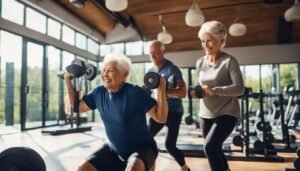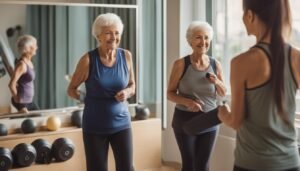Welcome to our article on senior yoga programs and the multitude of benefits they offer to older adults. At Sequoia Living, we understand the importance of promoting overall wellness and creating a balanced lifestyle for seniors in their golden years. Our senior yoga programs are designed to prioritize self-care, physical activity, and social connections, allowing seniors to thrive and enhance their well-being.
Key Takeaways:
- Senior yoga programs offer a multidimensional approach to wellness for older adults.
- These programs incorporate physical, social, and meaningful connections.
- By engaging in activities they love, seniors can enhance their overall well-being.
- Regular participation in senior yoga programs can promote strength, flexibility, and balance.
- Joining a supportive yoga community can combat feelings of isolation and foster social connections.
Integrating Wellness into Senior Living
At Sequoia Living, we understand that senior living should be more than just a place to reside. It should be a vibrant community that fosters well-being and enriches the lives of our residents. That’s why we have created holistic wellness programs that focus on physical, social, and meaningful connections.
Our wellness programs aim to provide opportunities for seniors to engage in physical activities that promote strength, flexibility, and overall health. From yoga classes to fitness sessions tailored to different abilities, we offer a range of options to suit individual preferences and needs.
In addition to physical activities, our programs also encourage social interactions among residents. We organize group outings, community events, and clubs that allow seniors to connect with like-minded individuals and build friendships. These social connections are essential for combatting feelings of isolation and loneliness, which can have a significant impact on overall well-being.
Creating Meaningful Connections
At Sequoia Living, we believe that meaningful connections are at the heart of a fulfilling retirement lifestyle. That’s why our wellness programs go beyond physical and social activities. We provide opportunities for residents to engage in activities that align with their passions and interests, whether it’s volunteering, pursuing lifelong learning, or participating in creative arts.
By integrating wellness into every aspect of senior living, we empower our residents to live their best lives. We encourage them to prioritize self-care and engage in activities that bring them joy and fulfillment. At Sequoia Living, we are committed to helping seniors thrive and create a balanced lifestyle that enhances their well-being.
| Wellness Programs | Physical Activities | Social Interactions | Meaningful Connections |
|---|---|---|---|
| Yoga classes | Yoga sessions catered to different abilities | Group outings and community events | Volunteering opportunities |
| Fitness sessions | Fitness programs for strength and flexibility | Clubs and interest groups | Lifelong learning opportunities |
| Wellness workshops | Guided walks and outdoor activities | Social gatherings and parties | Creative arts and crafts |
The Importance of Social Interaction for Seniors
Social interaction plays a crucial role in the well-being of seniors, particularly in combating feelings of isolation and loneliness. Studies have consistently shown that maintaining social connections is incredibly important for overall health and happiness, especially among older adults. Retirement communities, like Sequoia Living, recognize this need and provide opportunities for residents to cultivate new relationships, engage in group activities, and foster resilience and curiosity.
According to research, socially isolated seniors are at a higher risk of developing various health issues, including cardiovascular problems, cognitive decline, depression, and even premature death. On the other hand, seniors who actively participate in social interactions have been found to have better physical and mental health outcomes. They experience reduced levels of stress, increased happiness, improved cognitive function, and a higher sense of purpose in their daily lives.
A supportive community like Sequoia Living offers a wide range of social activities, allowing residents to connect with like-minded individuals and form meaningful relationships. These activities can include organized outings, group exercise classes, book clubs, arts and crafts workshops, and much more. By engaging in these communal experiences, seniors have the opportunity to share their interests, stories, and companionship, ultimately leading to a more fulfilling and enriched life.
Table: Benefits of Social Interaction for Seniors
| Benefits | Description |
|---|---|
| Improved mental health | Social interactions reduce the risk of depression and anxiety, promote better sleep, and enhance cognitive function. |
| Enhanced physical health | Seniors who maintain social connections tend to have lower blood pressure, stronger immune systems, and better overall physical health. |
| Increased longevity | Studies have shown that strong social ties are associated with a longer lifespan and a reduced risk of premature death. |
| Greater sense of purpose | Engaging in social activities can provide seniors with a sense of belonging, purpose, and fulfillment in their daily lives. |
It is essential for seniors to prioritize social interaction and actively seek out opportunities for connection and engagement. Retirement communities that offer a supportive and inclusive environment, like Sequoia Living, provide the necessary foundation for seniors to thrive, fostering social connections, and promoting overall well-being.
Creating a Healthy Retirement Lifestyle
A healthy retirement lifestyle is essential for seniors to maintain their well-being and experience joy in their golden years. At Sequoia Living, we believe that a healthy retirement lifestyle goes beyond physical health and clinical measures. It involves making daily choices that promote overall well-being, enhance social interactions, and bring joy. By prioritizing self-care and engaging in activities that nourish the mind, body, and soul, seniors can create a balanced and fulfilling lifestyle.
One way to create a healthy retirement lifestyle is by focusing on self-care. This includes taking care of one’s physical health through regular exercise and proper nutrition. It also involves prioritizing mental and emotional well-being by engaging in activities that bring joy and reduce stress. Whether it’s pursuing a hobby, practicing mindfulness and meditation, or spending quality time with loved ones, self-care plays a crucial role in maintaining a healthy and fulfilling retirement.
Another important aspect of a healthy retirement lifestyle is fostering social connections. Studies have shown that social interaction is vital for seniors as it helps reduce feelings of isolation and loneliness. By joining clubs, participating in group activities, and staying connected with friends and family, seniors can cultivate new relationships and build a supportive community. These social connections not only provide companionship but also contribute to improved mental and emotional well-being.
| Benefits of a Healthy Retirement Lifestyle: |
|---|
| Enhanced physical health |
| Improved mental and emotional well-being |
| Reduced risk of chronic diseases |
| Increased social connections |
| Greater sense of purpose and fulfillment |
A healthy retirement lifestyle is a journey that requires commitment and conscious choices. By focusing on self-care, fostering social connections, and embracing activities that bring joy, seniors can create a life filled with well-being, happiness, and fulfillment.
The Benefits of Exercise for Seniors
Exercise plays a vital role in maintaining the health and well-being of older adults. Regular physical activity can have numerous benefits, both for the body and the mind. Seniors who engage in exercise experience improved strength, flexibility, and cardiovascular health, among other positive outcomes. Let’s explore the benefits of exercise for seniors and why it is essential to incorporate physical activity into their daily routines.
Physical Benefits of Exercise
Regular exercise helps seniors strengthen their muscles and joints, reducing the risk of falls and injuries. It also improves balance and flexibility, allowing for better mobility and independence. Furthermore, exercise can combat chronic illnesses such as heart disease, diabetes, and osteoporosis, by reducing the risk factors associated with these conditions.
In addition to the physical benefits, exercise also has a positive impact on mental health. It can alleviate symptoms of depression and anxiety, boost mood and cognitive function, and improve sleep quality. Engaging in physical activity promotes a sense of well-being and can enhance overall quality of life for seniors.
The Importance of Physical Activity
It is crucial for seniors to stay active and incorporate exercise into their daily routines. Physical activity not only improves their physical health but also helps maintain cognitive function and social engagement. Whether it’s walking, swimming, dancing, or participating in group fitness classes, finding an enjoyable form of exercise is essential for seniors to stay motivated and maintain a healthy lifestyle.
| Benefits of Exercise for Seniors | Physical | Mental | Social |
|---|---|---|---|
| Improved strength and flexibility | Yes | Yes | No |
| Reduced risk of chronic illnesses | Yes | No | No |
| Alleviation of depression and anxiety | No | Yes | No |
| Enhanced cognitive function | No | Yes | No |
| Promotion of social engagement | No | No | Yes |
As we can see from the table above, exercise provides a wide range of benefits for seniors, both physically and mentally. It is essential for seniors to stay active and incorporate exercise into their daily routines to maintain their overall health and well-being.
Strengthening Muscles and Joints Through Exercise
Regular exercise plays a crucial role in strengthening muscles and joints for seniors. By engaging in moderate aerobic exercises, such as walking, swimming, or cycling, seniors can improve their mobility, relieve arthritis pain, and enhance overall physical well-being. These exercises target key muscle groups and help maintain joint flexibility, which is essential for maintaining a high quality of life in older adults.
According to medical experts, aerobic exercises stimulate blood flow to the muscles and joints, promoting healing and reducing inflammation. This can be particularly beneficial for seniors with arthritis or other joint-related conditions. Regular physical activity can also help manage chronic diseases, improve cardiovascular health, and provide an overall sense of well-being.
To showcase the benefits of aerobic exercise for seniors, the following table highlights key advantages:
| Benefits of Aerobic Exercise for Seniors |
|---|
| Strengthens muscles and joints |
| Relieves arthritis pain |
| Improves mobility and flexibility |
| Promotes cardiovascular health |
| Enhances overall well-being |
Incorporating regular aerobic exercise into a senior’s routine can have transformative effects on their physical health. It is important to consult with a healthcare professional or fitness instructor to develop a safe and effective exercise plan tailored to an individual’s specific needs and capabilities.
Managing Chronic Illnesses Through Exercise
Engaging in regular physical activity can significantly improve overall health and help manage chronic illnesses in seniors. Exercise has been shown to decrease pain, enhance well-being, improve cardiovascular health, increase strength and flexibility, and better manage chronic conditions. By incorporating exercise into their daily routine, seniors can take proactive steps towards managing their health and enjoying a higher quality of life.
Physical activity plays a crucial role in the management of chronic illnesses such as diabetes, heart disease, arthritis, and respiratory conditions. It helps control blood sugar levels, reduces the risk of cardiovascular events, strengthens bones and muscles, and improves lung function. Regular exercise also contributes to weight management, leading to better disease management and overall well-being.
In addition to the physical benefits, exercise also has a positive impact on mental health. It helps reduce symptoms of anxiety and depression, boosts mood, and promotes relaxation and stress reduction. Exercise releases endorphins, which are natural mood enhancers, providing seniors with a sense of well-being and improved mental clarity.
Exercise Recommendations for Seniors with Chronic Illnesses
While it’s important for seniors with chronic illnesses to engage in regular physical activity, it’s essential to consult healthcare professionals before starting any exercise program. They can provide guidance on appropriate exercises based on individual health conditions and limitations.
Here are some general exercise recommendations for seniors with chronic illnesses:
- Start with low-impact activities such as walking, swimming, or cycling.
- Gradually increase the duration and intensity of exercise sessions.
- Include a mix of cardiovascular exercises, strength training, and flexibility exercises.
- Listen to your body and make modifications as needed to prevent injury or exacerbation of symptoms.
- Engage in activities that you enjoy to maintain motivation and consistency.
| Chronic Illness | Recommended Exercises |
|---|---|
| Diabetes | Walking, cycling, swimming, yoga |
| Heart Disease | Low-impact aerobics, light strength training, stretching |
| Arthritis | Water aerobics, Tai Chi, gentle yoga, range-of-motion exercises |
| Respiratory Conditions | Breathing exercises, walking, swimming |
“Exercise is medicine for seniors with chronic illnesses. It is a powerful tool that can improve both physical and mental well-being, providing a sense of control and empowerment in the management of chronic conditions.”
In conclusion, regular physical activity is an essential component of managing chronic illnesses in seniors. By incorporating exercise into their daily routine and following appropriate guidelines, seniors can experience improved physical health, enhanced mental well-being, and better overall disease management.
Boosting Cardiovascular Health with Exercise
Regular exercise is essential for maintaining and improving cardiovascular health in seniors. Engaging in physical activities that get the heart rate up and increase blood flow can reduce the risk of heart disease and boost overall well-being. By incorporating regular exercise into their routine, seniors can enhance their cardiovascular health and enjoy a higher quality of life.
Aerobic exercises like brisk walking, running, swimming, and cycling are particularly effective at strengthening the heart and improving cardiovascular function. These activities not only increase heart rate, but also help to lower blood pressure, improve circulation, and reduce the risk of clogged arteries. By consistently engaging in cardio exercises, seniors can reduce the likelihood of developing heart disease and improve their overall heart health.
Strength training exercises are also important for cardiovascular health. By building lean muscle mass, seniors can increase their metabolism and improve their body’s ability to efficiently pump blood. Strength training exercises also help to maintain bone density, improve balance, and reduce the risk of falls. Incorporating strength training into a regular exercise routine can have significant benefits for seniors looking to boost their cardiovascular health.
“Regular exercise, both cardio and strength training, plays a crucial role in promoting cardiovascular health in seniors. By engaging in activities that get the heart pumping and improve circulation, seniors can reduce the risk of heart disease and enjoy a healthier heart.” – Dr. Emily Johnson, Cardiologist
| Activity | Duration | Frequency |
|---|---|---|
| Brisk Walking | 30 minutes | 5 times per week |
| Running | 20 minutes | 3 times per week |
| Swimming | 30 minutes | 3 times per week |
| Cycling | 30 minutes | 3 times per week |
| Strength Training | 20 minutes | 2 times per week |
Improving Mental Well-Being Through Exercise
Exercise is not only beneficial for physical health but also plays a crucial role in improving mental well-being. For seniors, engaging in regular exercise can have a positive impact on managing symptoms of depression and anxiety, enhancing cognitive function, and promoting better sleep.
Research has shown that exercise stimulates the release of endorphins, also known as “feel-good” hormones, which can help alleviate symptoms of depression and anxiety. Whether it’s going for a brisk walk, practicing yoga, or participating in group exercise classes, seniors can experience a boost in mood and overall well-being.
In addition to its effects on mental health, exercise has been found to improve cognitive function. Aerobic activities that get the heart pumping can increase blood flow to the brain, promoting better memory, attention, and problem-solving skills. Seniors who regularly engage in physical activity may experience improved cognitive abilities and a reduced risk of cognitive decline.
| Exercise for Mental Well-Being | Benefits |
|---|---|
| Yoga | Reduces stress, promotes relaxation, improves mood, and enhances mental clarity. |
| Group Exercise Classes | Provides social interaction, boosts mood, increases motivation, and decreases symptoms of depression and anxiety. |
| Walking or Jogging | Enhances mood, reduces stress, and improves cognitive function. |
By incorporating exercise into their daily routine, seniors can take control of their mental well-being and experience the many benefits it offers. Whether it’s through yoga, group exercise classes, or simply going for a walk, staying active can contribute to a more fulfilling and balanced life in their golden years.
The Transformative Power of Yoga for Seniors
Yoga is a holistic practice that offers numerous physical and mental health benefits for seniors. Through a combination of gentle movements, stretching, and breathing exercises, yoga can help seniors improve their strength, balance, and flexibility. This can be particularly beneficial for seniors who experience back pain, arthritis symptoms, and an increased risk of heart disease.
In addition to the physical benefits, yoga also promotes mental well-being in seniors. It can help reduce stress, promote relaxation, and improve sleep quality. Yoga has also been shown to alleviate symptoms of depression and anxiety, enhance cognitive function, and support the healing process for seniors going through illness or recovering from surgery.
By incorporating yoga into their routine, seniors can experience a transformative journey towards improved physical and mental health. Whether practicing in a group setting or through one-on-one sessions with a yoga therapist, seniors can find a supportive community that fosters social connections and personalized yoga plans that complement their medical treatments.
“Yoga is not about touching your toes. It’s about what you learn on the way down.” – Judith Hanson Lasater
Physical and Mental Health Benefits of Yoga for Seniors
The physical and mental health benefits of yoga for seniors are numerous and impactful. Here are some key benefits:
- Improved Strength: Yoga poses help strengthen muscles, leading to better stability and mobility.
- Enhanced Balance: The focus on balance in yoga can reduce the risk of falls and improve overall stability.
- Increased Flexibility: Regular yoga practice can improve flexibility, making daily activities easier and preventing injuries.
- Reduced Pain: Yoga can alleviate chronic pain, including back pain and arthritis symptoms, by improving muscle strength and flexibility.
- Cardiovascular Health: Certain yoga styles, such as Ashtanga and Vinyasa, offer cardiovascular benefits by increasing heart rate and improving circulation.
- Mental Well-being: Yoga promotes relaxation, reduces stress, and enhances mental clarity and focus.
| Physical Benefits | Mental Benefits |
|---|---|
| Improved strength, balance, and flexibility | Reduced stress and anxiety |
| Alleviation of back pain and arthritis symptoms | Enhanced mood and overall well-being |
| Increased cardiovascular fitness | Improved cognitive function and memory |
Overall, yoga offers a holistic approach to senior well-being, addressing both the physical and mental aspects of health. By embracing the transformative power of yoga, seniors can cultivate a sense of balance, strength, and peace as they navigate their golden years.
Joining a Supportive Yoga Community
Participating in yoga classes provides seniors with a supportive community where they can engage in group healing, find support, and combat loneliness. The power of a supportive community cannot be underestimated when it comes to wellness in senior living. It creates a sense of belonging, fosters connections, and encourages individuals to support and uplift one another on their wellness journey.
Yoga classes offer a safe and inclusive space for seniors to come together, share their experiences, and build meaningful relationships. The shared practice of yoga cultivates a sense of unity and camaraderie among participants. It allows seniors to connect with others who share similar interests and goals, creating an environment of encouragement and mutual support.
One-on-one sessions with a yoga therapist can also be a valuable addition to a senior’s yoga practice. These personalized sessions allow for a tailored approach to addressing specific needs and goals. A yoga therapist can work closely with seniors to develop a personalized yoga plan that complements their medical treatments, promotes overall well-being, and addresses any limitations or concerns they may have.
Benefits of Joining a Supportive Yoga Community:
- Opportunity for group healing
- Combat feelings of loneliness and isolation
- Sense of belonging and connection
- Encouragement and support from others
- Personalized yoga plans with a yoga therapist
“Being part of a supportive yoga community has had a profound impact on my overall well-being. I’ve made new friends, found encouragement during challenging times, and discovered a deeper sense of connection within myself and others. The personalized yoga plan developed by my yoga therapist has helped me address my specific needs and limitations, allowing me to fully experience the benefits of yoga.”
By joining a supportive yoga community, seniors can enhance their well-being and experience the transformative power of yoga. Whether it’s through group classes or one-on-one sessions with a yoga therapist, the opportunities for growth, healing, and connection are endless.
| Benefits of Joining a Supportive Yoga Community |
|---|
| Opportunity for group healing |
| Combat feelings of loneliness and isolation |
| Sense of belonging and connection |
| Encouragement and support from others |
| Personalized yoga plans with a yoga therapist |
Conclusion
Senior yoga programs have the transformative power to greatly enhance the well-being of seniors in multiple aspects – physical, mental, and social. By incorporating yoga into their routine, seniors can experience improved strength, balance, flexibility, and reduced pain. Regular engagement in a supportive yoga community fosters social connections and provides a holistic approach to overall well-being.
At Sequoia Living, we understand the importance of senior yoga programs and the numerous benefits they offer. Our programs are designed to cater to the specific needs of seniors, promoting a balanced and fulfilling lifestyle. Through our multidimensional approach, we prioritize self-care and encourage seniors to participate in activities they love, enhancing their overall quality of life.
By joining a senior yoga program, older adults can experience the transformative power of yoga and unlock the full potential of their well-being in a supportive and inclusive environment. The combination of physical exercise, mental relaxation, and social interaction creates a comprehensive wellness experience tailored to address the unique needs of seniors.
FAQ
What are the benefits of senior yoga programs?
Senior yoga programs offer a range of benefits, including improved strength, balance, flexibility, reduced pain, and relaxation. They can also alleviate symptoms of back pain, arthritis, and heart disease risk.
How do senior yoga programs promote overall wellness?
Senior yoga programs promote overall wellness by incorporating physical, mental, and social aspects. They provide opportunities for exercise, stress management, relaxation, and social engagement, which can enhance well-being and create a balanced lifestyle.
Can yoga help seniors manage chronic illnesses?
Yes, regular participation in yoga can help seniors manage chronic illnesses. It can provide relief from pain, improve cardiovascular health, enhance mental well-being, and support overall chronic condition management.
Is joining a supportive yoga community beneficial for seniors?
Yes, joining a supportive yoga community can be highly beneficial for seniors. It provides a space for group healing, support, and social connection. One-on-one sessions with a yoga therapist can also help create personalized yoga plans that complement medical treatments.
What if I have never done yoga before? Is it still suitable for me?
Absolutely! Yoga can be modified to accommodate seniors of all levels of experience and physical abilities. It is never too late to start practicing yoga and experience its numerous benefits. Beginners are always welcome in senior yoga programs.






